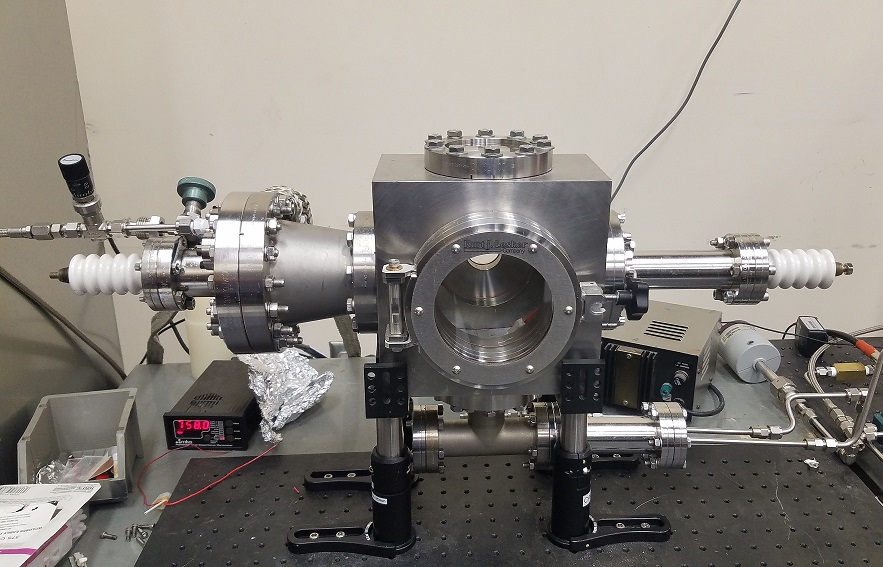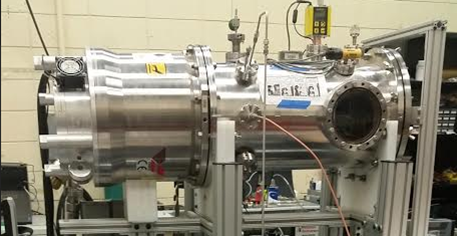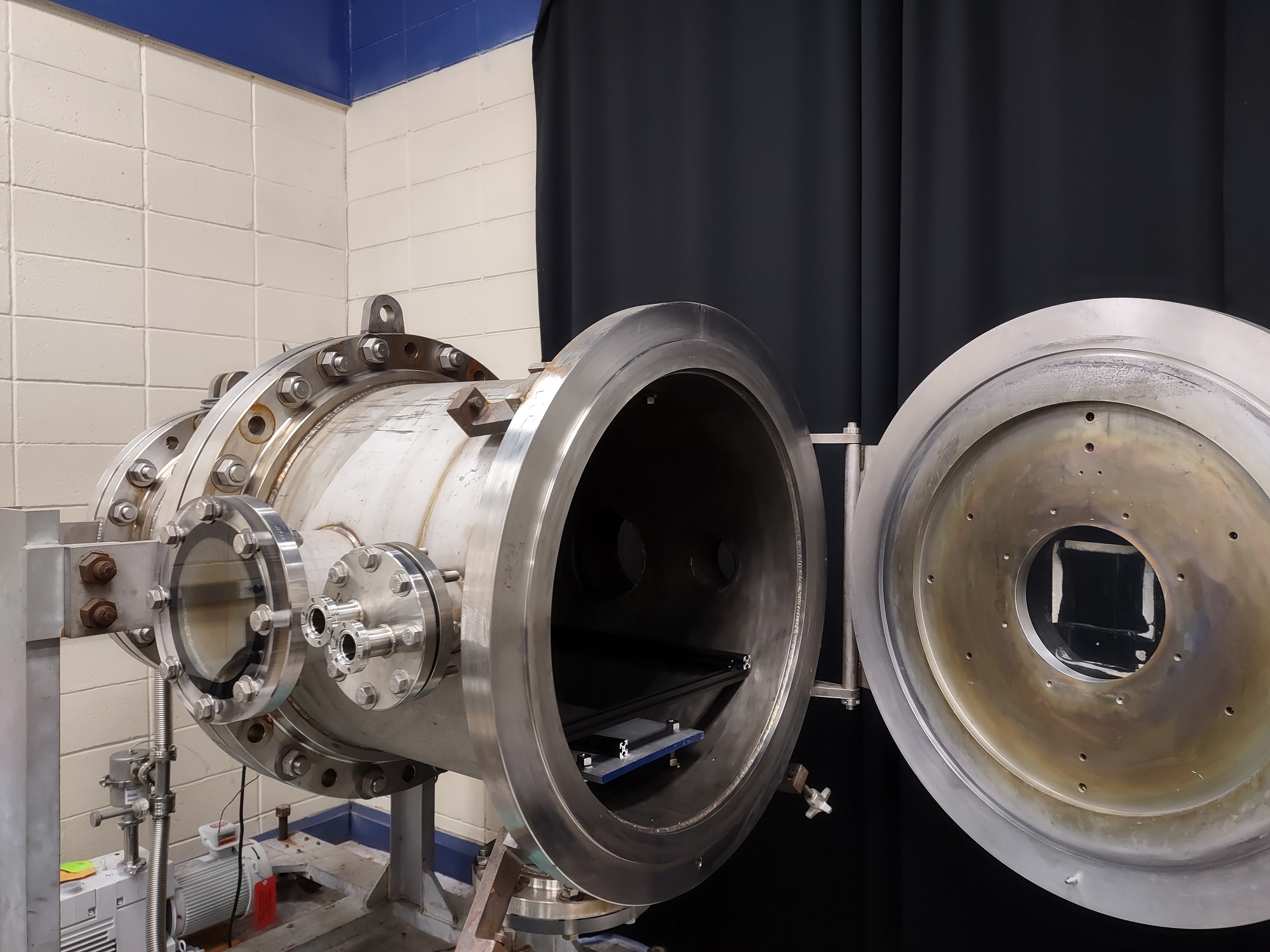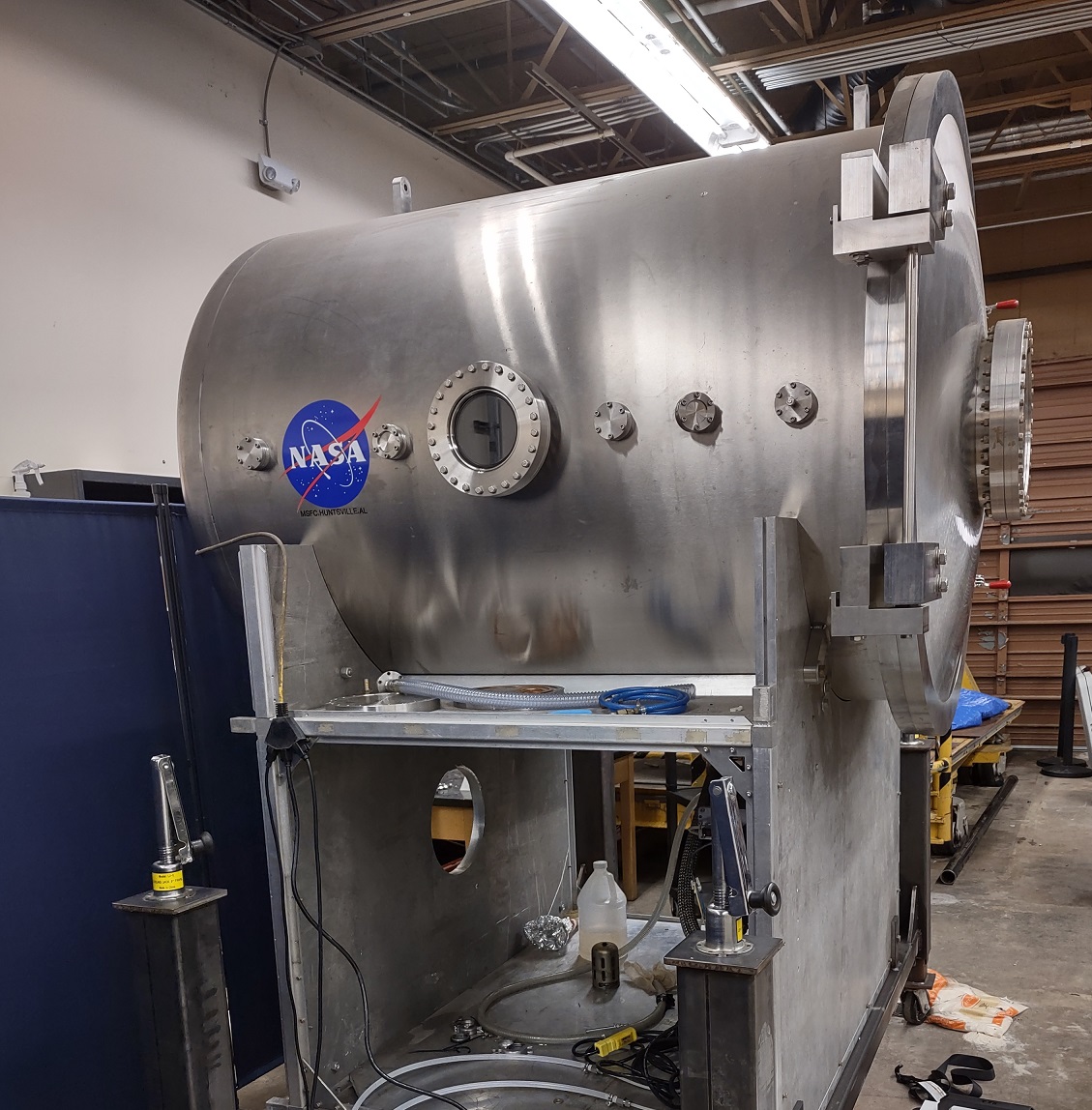Facilities
PERL conducts experimental research on plasmas and combustion. We also have access to the facilities at the Propulsion Research Center (PRC).
Vacuum Chambers
PERL has four vacuum chambers used for low pressure experiments. The cube chamber is 8x8x6 inches and is used for small basic plasma experiments. The chamber pressure is controlled with a mechanical pump, needle valve, and mass flow controller. The chamber is typically used for near atmospheric plasma research in various gas mixtures.

The small turbo chamber is 2 ft long and 1 ft in diameter. Various feedthrough ports and windows allow instrument and visual access. The chamber is pumped by a Osaka Vacuum turbomolecular pump with a pumping speed of 3200 /s on air and a base pressure of 1 x 10-6 Torr for a clean and empty chamber.

The diffusion pumped chamber is 3 ft long and has two section 2 ft and 3 ft in diameter. The chamber is evaculated with an VHS-10 oil diffusion pump with a pumping speed of 5300 l/s on air to a base pressure of ~6 x 10-5 Torr.

The NASA chamber is 4 ft diameter and 6 ft long and evacuated with a ATP 400 turbomolecular pump with a pumping speed of 400 l/s on air.

Power Sources
We have a range of power sources from DC to RF. The main sources used include:
- High voltage pulsed DC. 0-10 kV, 200 ns min pulse width, 0-10 kHz rep rate.
- Low voltage pulsed DC. 0-1.5 kV, 60 ns min pulse width, 0-240 kHz rep rate.
- RF generator. 14 MHz, 100 W base, 2 kW with amplifier, T-type manual matching network.
- Microwave generator. 800-1000 MHz, 10 W amplified power.
- Solid state thyristor triggered pulsed power system (6 kA, 6 MW peak) for pulsed plasma discharges
- Various DC power supplies.
Combustion
We have the capability to construct and test combustion rigs of various sizes and pressure. Experiments have used simple Bunsen burners, Rijke tubes, multi-element burners, pentad rocket injectors, linear detonation tube, and rotating detonation engine.
Diagnostics
PERL employs a range of commercial and lab built diagnostics and tools to study combustion and plasmas phenomenon.
Lasers
A TSI TDL+ dye laser system is employed to conduct laser induced florescence (LIF) measurements of combustion and plasma processes. Properties such as species concentration and temperature can be readily measured with LIF. The system is pumped with a Brilliant B Nd:YAG pulsed laser (~1 J class).
Three Continuum Surelite Nd:YAG lasers (~1 J class) and two Minilite Nd:YAG lasers (~10 mJ class) are also used for scattering diagnostics and laser-induced plasma studies.
We also have an Innolas ruby laser capable of 10 J, 20 ns pulses.
Princeton Instruments SP2500 Spectrometer/Monochromator
The SP2500 is a spectrometer/monochromator system that is used to conduct optical emission spectroscopy of flames and plasmas. The instrument can be used either as a wide spectrum spectrometer or tight band monochromator depending on the set up. A Princeton Instruments PI-MAX 4 spectroscopy camera and a Hamamatsu PMT can be connected for use as a spectrometer or monochromator.
Fast Gate Cameras
Two fast gate time cameras are used for synchronized time-resolved imaging and spectroscopy. An Andor iStar 334T ICCD camera (1024 x 1024) with 200-800 nm spectral range is used for direct imaging with or without a spectral filter. A Princeton Instruments PI-MAX 4 ICCD camera (1024 x 256) with 200-1000 nm spectral range is used for spectroscopy with the SP2500 spectrometer. Both cameras have minimum gate widths of 3 ns and frames rates of 10 Hz.
An Axiom Optics HiCATT 18 intensified relay optic (IRO) is used to provide fast gating to high-speed CMOS cameras. The IRO has a 40 ns min gate width and default max speed of 1 MHz, with short term boost to 5 MHz. The photocathode is optimized for the UV 200-450 nm with extension to 700 nm.
Plasma Probes
Physical probes such as Langmuir probes, also known as electrostatic probes, Faraday probes, retarding potential analyzers, and ExB probes are used to measure various plasma and thruster plume properties includes plasma potential, electron temperature, electron number density, ion number density, electron energy distribution function, ion energy, and plume angle.
RGA Mass Spectrometer
A portable mass spectrometer based on a residual gas analyzer (RGA) is used to measure relative quantities of gaseous species. The RGA uses a quadrupole mass analyzer to detect the different gas atoms and molecules. The system is pumped with a turbomolecular pump to main high vacuum in the RGA section. A fine control needle valve and an thin gas chromotography column is used create a large pressure drop and bring the atmospheric gas into the system for analysis, while maintaining high vacuum. The system can measure up to 100 amu species.
Other Diagnostic Equipment
PERL has an array of standard diagnostics such as oscilloscopes, high voltage probes, Pearson current monitors (Ragowski coils), multimeters, thermocouples, low and high frequency pressure transducers, etc. High-speed CMOS cameras are available for use on loan from the PRC.